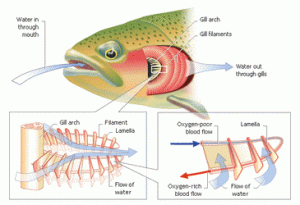Fish obtain oxygen through their gills. Gills are specialized organs that extract oxygen from water. As water flows over the gills, oxygen from the water diffuses into the fish’s bloodstream, while carbon dioxide, a waste product, diffuses out into the water. The gills have thin-walled filaments with a large surface area to maximize oxygen absorption. This allows fish to extract dissolved oxygen efficiently from their aquatic environment.
Know More About: how do fish get oxygen
Fish, fascinating creatures of the aquatic world, have an incredible method of obtaining oxygen that enables them to survive and thrive beneath the surface. As we submerge ourselves into the depths of this topic, we will dive into the intricacies of how fish obtain the life-giving oxygen that they need to survive.
To understand this phenomenon, let’s begin with the gills. Fish have specialized organs, known as gills, which act as their respiratory system. These gills, located on either side of their body, are comprised of thin, delicate filaments. Through the process of diffusion, oxygen is extracted from the water as it flows across these filaments.
Water enters the fish’s mouth and flows over the gill filaments, where it encounters a vast network of tiny blood vessels known as capillaries. These capillaries are exceptionally close to the surface of the gills, allowing for the efficient exchange of gases. As water passes over the gill filaments, oxygen molecules diffuse across the thin walls of the capillaries and into the fish’s bloodstream. Simultaneously, carbon dioxide, a waste product, diffuses out of the fish’s bloodstream and into the surrounding water. This intricate exchange ensures that the fish receives the necessary oxygen, all while efficiently eliminating waste.
With this knowledge, we must also explore how fish are capable of extracting oxygen from the water, while humans and other mammals rely on atmospheric oxygen. Unlike us, fish possess a unique adaptation that enables them to exploit the oxygen available in their aquatic environment. Specifically, they extract oxygen from water by utilizing the high oxygen content present in their surroundings.
The concentration of oxygen in water is significantly lower than in the air, making it more challenging for fish to extract enough oxygen to meet their metabolic needs. To overcome this obstacle, fish have developed several adaptations to enhance oxygen uptake. For instance, some species have evolved elaborate gill structures. These intricate gill arches are made up of numerous secondary gill filaments, increasing the surface area available for gas exchange. This augmented surface area allows for a more efficient extraction of oxygen from the water, enabling fish to survive in their oxygen-deficient habitat.
Additionally, fish have adapted their behavior to maximize oxygen intake. They are often seen swimming with their mouths open, forcing water through their gills, increasing the flow rate and subsequently augmenting oxygen diffusion. Some species even utilize buccal pumping, a technique where fish forcefully pump water into their mouths and across their gills. By actively pumping the water, they can extract oxygen effectively, compensating for the low oxygen concentrations present in their environment.
Moreover, certain fish species possess specialized accessory respiratory structures that further enhance their oxygen uptake capacity. For instance, labyrinth organs, found in labyrinth fish such as bettas, allow them to extract oxygen directly from the air above the water’s surface. This unique adaptation gives them an advantage in environments with lower oxygen concentrations or during periods of hypoxia when oxygen levels are exceptionally low.
In conclusion, fish have undoubtedly mastered the art of acquiring oxygen in their unique underwater world. Through their intricate gill system, fish can efficiently extract oxygen from the surrounding water. Adaptations such as elaborate gill structures and buccal pumping contribute to their ability to maximize oxygen uptake. Additionally, some species possess accessory respiratory organs that enable them to extract oxygen from the air above the water. These remarkable adaptations allow fish to thrive in their underwater habitats, showcasing the wonders of nature’s diversity and the amazing ways in which different species have evolved to survive and flourish.
FAQs on how do fish get oxygen
1. How do fish get oxygen underwater?
Fish extract oxygen from the water through their gills. As water passes over the gills, tiny blood vessels absorb the dissolved oxygen, which is then transported to their cells.
2. Do fish breathe air like humans?
No, unlike humans and other mammals, fish do not breathe air. They rely on extracting oxygen from the water using their specialized gills.
3. Can fish get oxygen from the surface of the water?
Some species of fish, such as lungfish, have the ability to gulp air from the water’s surface. They possess specialized lungs that allow them to extract oxygen from the air when the water conditions are not suitable.
4. How do gills function in extracting oxygen?
Gills consist of thin filament-like structures that are rich in blood vessels. As water flows over the gill filaments, oxygen in the water diffuses into the fish’s bloodstream, while carbon dioxide is released back into the water.
5. Can fish absorb oxygen through their skin?
Although fish primarily rely on gills, some species, such as catfish, have thin skin that allows limited oxygen absorption. However, their main source of oxygen is still through their gills.
6. Why do fish need oxygen?
Like all living organisms, fish require oxygen for cellular respiration, which provides energy for their bodily functions. Oxygen is vital for their survival and maintaining their metabolism.
7. How do fish obtain the oxygen dissolved in water?
Water contains oxygen molecules that dissolve from the atmosphere or through photosynthesis by aquatic plants. Fish extract this dissolved oxygen from the surrounding water using their gills.
8. Is the amount of available oxygen in water constant?
The level of oxygen in water can vary depending on various factors such as temperature, salinity, and the presence of aquatic plants. Fish require sufficient dissolved oxygen for their survival.
9. Can fish survive in oxygen-depleted water?
Fish have varying tolerance levels for low oxygen conditions. Some species have adaptations that enable them to survive in oxygen-poor environments, while others might resort to moving to areas with higher oxygen concentration.
10. How do fish behave when oxygen levels are low?
When oxygen levels are low, fish may display signs of distress such as gasping at the water’s surface or swimming erratically. Some species might also reduce their activity levels and seek areas with higher oxygen availability.

